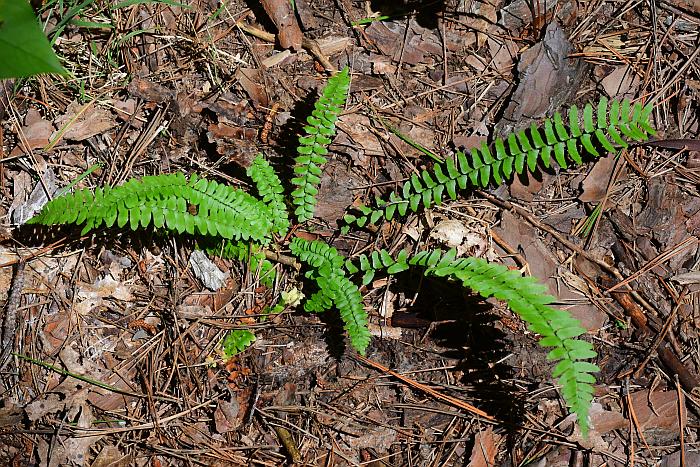Asplenium platyneuron (L.) Britton, Sterns & Poggenb.
Ebony Spleenwort

Native
CC = 4
CW = 3
MOC = 79
© SRTurner
Asplenium platyneuron (L.) Britton, Sterns & Poggenb.Ebony Spleenwort | |
 |
Native CC = 4 CW = 3 MOC = 79 |
© SRTurner |
|
Family - Aspleniaceae Habit - Perennial, homosporous fern ally. Rhizomes erect to short-creeping, compact, scaly, the scales clathrate (the endwalls colored, the centers transparent or nearly so). Leaves - Clustered, 5-50 cm long, somewhat dimorphic, the vegetative leaves shorter, prostrate to arching, with shorter pinnae. Petioles reddish brown to dark brown their entire length, shiny, the color extending to nearly the tip of the rachis. Leaf blades pinnately compound, linear to narrowly oblanceolate in outline. Pinnae mostly alternate on the rachis, 4-35 mm long, the median pinnae 7-35 mm long, oblong to narrowly deltoid or nearly linear, the margins shallowly to sometimes deeply toothed, mostly auriculate at the base of the upper margin, the base truncate to broadly rounded, mostly overlapping the rachis. Veins not anastomosing.
Sporangia - Aggregated into sori on leaf undersides. Indusium membranous, attached along 1 side. Spores 64 per sporangium, 25-60 um long, black.
Gametophytes - Green, flat, heart-shaped to kidney-shaped, often with stalked glands. Fertile - May - September. Habitat - Shaded banks and slopes in mesic to upland forests, less commonly in crevices of boulders and bluffs, on both calcareous and noncalcareous substrates. Origin - Native to the U.S. Lookalikes - Other species of Asplenium; more broadly, ferns in general. Other info. - This common fern ally is relatively inconspicuous, remaining relatively small throughout its life. Like all ferns, it lacks flowers and reproduces via spores, which are produced in sporangia on the undersides of the leaf pinnules. The plant is found across Missouri except for the northwestern quadrant, where it is uncommon or absent, and also across the eastern half of the U.S. It is recognized by its pinnately compound leaves arising from the ground, the fertile ones bearing the characteristic sori on the undersides. The rachis (central stem of the leaf) is dark in color and shiny along its entire length, and the pinnules have auricles ("ears") at their bases but are otherwise undivided. The pinnules are mostly arranged alternately along the rachis. Photographs taken at Young Conservation Area, Jefferson County, MO, 8-17-2020 (SRTurner). |